All Access: Rush
Clockwork Angels Tour
By Steve Jennings, MixOnline.com, January 1, 2013
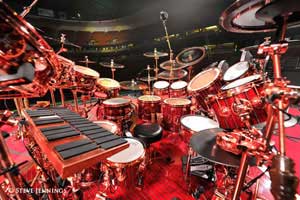
Neil Peart's drum kit mics: Snare Top, Audio-Technica 23he; Snare Bottom, A-T AE3000 and Shure SM 98; Rim Shot/X-stick, Shure SM98; Kick, A-T AE2500 dual element; Hi-Hat, A-T 450; Ride, A-T 5100; Toms 1-2-3, A-T 350; Toms 4-5-6-7-8, A-T 3000; Splash Cymbals, Shure SM98; China Cymbal, A-T 4050; Overheads, A-T 4060 Tube Pre Mic; Piccolo Snare Top, A-T 23he, Bottom A-T 3000; Cowbells, A-T Ribbon Mic.
Geddy Lee, Alex Lifeson, Neil Peart...now that's a power trio. Mix caught Rush on its 2012 Clockwork Angels tour in November at the Honda Center in Anaheim, Calif., for a rockin' two-and-a-half-hour show.
FOH engineer Brad Madix first started working with Rush in 1990 for the Presto tour as the fifth man on a four-man sound crew, back when Robert Scovill was mixing FOH and Ted Leamy was the System Tech for Electrotec. He came on as full-time FOH mixer on 2002's Vapor Trails tour, jumping into digital systems early with the Yamaha PM1D. In 2006, the band switched to Avid Profile.
"I really like the ability to use TDM plug-ins in the live environment," Madix says. "I gravitate toward plug-ins that warm things up - Waves Vintage stuff, for example, or Cranesong Phoenix. But there are also a few go-to problem solvers like Waves C6 and the H-EQ for feedback control."
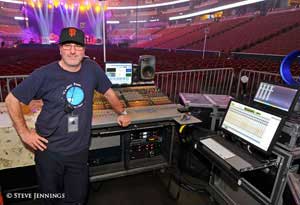
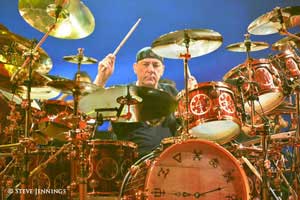
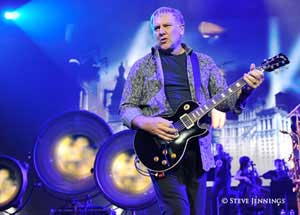
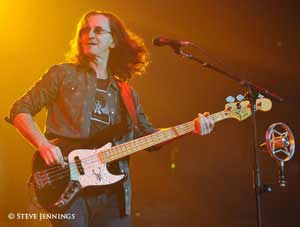
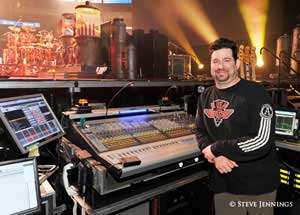
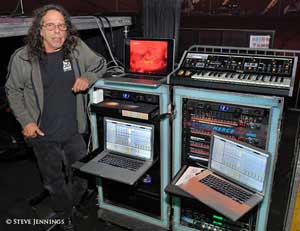
The band has been using the Audio-Technica AE6100 vocal mics for a few tours now. This tour includes a small string section of six violins and two cellos, which required a bit of research into what was new in piezo pickups. "I was looking at preamps to go along with the pickups and wasn't really happy with the selection," Madix says. "I wanted to avoid placing eight boxes - each with 3-band EQ, feedback suppression, compression and what-have-you - across a riser in front of eight people. I just wanted to get the signal to the preamps with as little degradation as possible. It turned out Radial was just releasing the PZDI, and it was exactly what we needed. We settled on Fishman V200 pickups for the violins and Mighty-Mini pickups for the cellos, all running through the PZDIs into a rack of Harrison preamps just behind the string riser.
"For P.A., we're using a Clair Brothers i5 system, 14 deep per side with a matching complement of the i5b bass bins," he continues. "On the offstage, we're hanging ten deep i5s without the b's. Across the front of the stage, we've got a timed array of eight double-18 subs, spaced eight feet apart, each with a small front-fill on top to hit the front row."
"Neil's acoustic kit has seven different sample pads," monitor engineer Brent Carpenter says. "He also utilizes an entire Roland V-Drum kit; we call it the Back Kit. The ones that are strictly used for samples go to a Roland 5080 sample playback/synthesizer system, the ones that are associated with the Back Kit go to a Roland TD-30 drum module and then MIDI out to the Roland 5080 system as well. This gives them the choice of using the stock installed sounds in the TD-30 or to use something more customized through the 5080" photo of Alex Lifeson
Guitarist Alex Lifeson uses the new Lerxst amps from Mojotone. "It is basically a copy of the old 2553 Marshall Silver Jubilee heads that haven't been made for quite some time," says guitar tech Scott Appleton. "We are also using a Mesa Boogie MK5 and a Hughes and Kettner Coreblade. No mics, as there are no speaker cabinets. We use a Palmer PDI-03 Speaker Simulator to run each of them direct.
"Our rack consists of the Fractal Audio AxeFX II for effects on the Lerxst and Mk5, as well as Apple's MainStage program running Native Instruments Guitar Rig 5, UAD and Apple plug-ins," Appleton continues. "We also have a Dunlop rackmout Crybaby Wah, a Mesa Boogie High Gain Amp Switcher, two RJM Music Amp Gizmos, an RJM Music Effect Gizmo, two Apple MacBook Pros, two UA Apollo Quads and a backup AxeFX II. We are also using a third AxeFX II for the piezo electronics. Last, we are using Audio Technica 5300 Series wireless and two RJM IS-8 Input Selectors."
"Alex's foot pedal gear are an Axxess Electronics FX-1, a Tech 21 Midi Moose, an Ernie Ball volume pedal and a Dunlop Crybaby controller pedal."
Geddy Lee's Bass Tech is John "Skully" McIntosh. He maintains four Shure UR4-d wireless systems; his rack consists of SansAmp, Avalon U-5, and Palmer PDI-5 Direct and Palmer PDI-05 as a cabinet simulator after an Orange AD200B MKIII Bass Head (no cabinet).
Monitor engineer Brent Carpenter also works on an Avid Profile. "I use the input side of the board - preamps, gain, EQ, comps, gates, plug-ins, etc. - pretty much as an analog console. I very rarely use the software to change those parameters. I do, however, extensively use it to change output information - routing, aux sends, VCA assigns etc. There are over 300 snapshots for this show. Not much for a theater gig but quite a few for a rock show."
He also makes extensive use of plug-ins, including McDSP MC2000, Analog Channel, Channel G and Channel G Compact, the 6030 Ultimate Comp and Classic EQ, Eventide Anthology II for reverbs and delays, Cranesong Phoenix, Digidesign Eleven, and Impact!
The band is on ears, with six channels of Shure PSM 1000 with Ultimate Ears UE-18 Pros.
Tony Geranios is Rush's Keyboard Tech: "Onstage, Geddy uses three MIDI controllers: a Roland X7 and two Korg MPK 130 MIDI pedals. Alex has two MIDI controllers onstage: one Korg MPK 130 and a Roland JUNO DI. These five controllers are routed to my workstation off stage right. The gear I use consists of two racks with three MacBook Pros with solid-state HD, two Anatek Studio Merge, two MIDI Solutions M8, four Roland MKS 900 MIDI displays, two MOTU 828s and one Radial SW8 Audio Switcher. I run Ableton Live for sample playback. I also have a Moog Little Phatty to test and edit the patches and samples. During the show I monitor the samples and change the song patches."